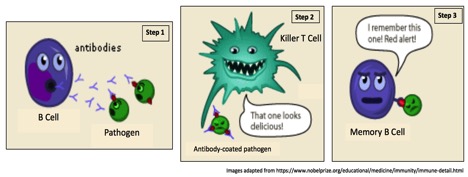By Clare Gyorke
When I say the flu sucks, I’m not talking about the cold you get every year – you feel crappy for a day or two, but not so crappy that you can’t watch Netflix. I’m talking about the one that starts out feeling like a cold, but progresses to feeling so bad that you can’t do anything but sleep for a week. While the early symptoms of both infections are indistinguishable, the achiness, fever and discomfort brought on by influenza virus progress for several days and make people feel sick enough that they describe feeling ‘like they want to die’. Many people actually do die from the flu every year because the fluid that builds up in their lungs during infection exacerbates a pre-existing chronic illness (like COPD) or results in another infection that they cannot fight off (like bacterial pneumonia).
One way to help limit the number of flu-related deaths is by limiting the number of infected people in the general population. This is accomplished when many people get the flu shot, which creates ‘herd immunity’. Immunizing the ‘herd’ offers protection by reducing the number of infectable hosts, and can be a matter of life and death for those whose immune systems aren’t strong enough to fight off infection (like someone on chemotherapy) or for those who cannot get vaccinated (like babies). But how does the flu shot work?
The flu shot contains killed virus particles designed to show your immune system what flu looks like so it will ‘remember’ and respond very quickly if it sees that particular flu again. How does the immune system remember? Well, any time your body sees a pathogen like the flu, the pathogen is sent to a lymph node where immune cells ‘chat’ and compare to see if they have ‘seen’ it before. If they haven’t seen it, the ‘Generals’ of the Immune System Army, known as the T cells, will begin to attack the pathogen. First, they instruct B cells to make antibodies to the pathogen. Antibodies are sticky little flags that stick very well to that particular pathogen (see image). Killer T cells (different from the Generals) find antibody-flagged pathogens and kill them by ‘eating’ them. When most of the pathogen has been eaten up, all but a select few killer T cells and B cells die, and the remaining few convert to long-lived ‘memory’ B cells and T cells. These memory B cells circulate through different lymph nodes for months to even years, screening for their specific pathogen and ready to respond at a single sighting. What’s great about a vaccine is that the viral particles in the shot are dead: you won’t get full-blown flu symptoms, but you will generate memory of those particles. (You might get some minor symptoms: these are actually very good, and a sign that your body is responding to the vaccine and generating memory. But don’t worry if you don’t get symptoms, your body is still responding!)
At this point, you might be wondering why you have to get a shot every year, if your immune system remembers every pathogen it ‘sees’. Well, iInfluenza fights back and tries to avoid immune detection by constantly making slight changes to its surface proteins (the antigens). This is called ‘antigenic drift’, and these changes eventually accumulate to make an antigen that your immune system no longer recognizes. Every year, scientists at the Center for Disease Control (CDC) try to predict the top three or four strains (different strains are defined by different antigen combinations) most likely to be epidemic, and those go into that year’s vaccine. This list can change each year, which is why you need to re-vaccinate. Annual vaccination saves lives by maintaining ‘herd immunity’, and protects both you and those who are highly susceptible to flu from a horrible illness and potential death – so get your flu shot and protect your loved ones!
Edited by Anna Chiarella and Eva Vitucci

